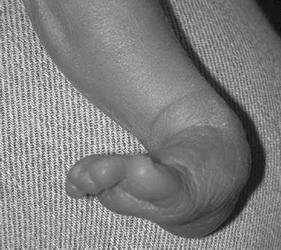Calcaneovalgus Foot
Editors: Frassica, Frank J.; Sponseller, Paul D.; Wilckens, John H.
Title: 5-Minute Orthopaedic Consult, 2nd Edition
Copyright ©2007 Lippincott Williams & Wilkins
> Table of Contents > Calcaneovalgus Foot
Calcaneovalgus Foot
Paul D. Sponseller MD
Description
-
Calcaneovalgus foot is a congenital condition thought to result from intrauterine positioning (1).
-
The hindfoot is held in valgus and the
foot is markedly dorsiflexed, with the dorsum of the foot nearly
touching the anterior tibia.
Epidemiology
-
The condition occurs in neonates.
-
No gender predominance is noted.
-
It is one of the most common congenital foot disorders.
Prevalence
Present to varying degrees in 5% of all births
Pathophysiology
-
The Achilles tendon is stretched temporarily, but it recovers spontaneously after birth.
-
No bony abnormalities are present.
Associated Conditions
-
Infants with a calcaneovalgus foot should be checked for other positioning deformities, such as DDH or torticollis.
-
No evidence suggests that this condition may predispose the patient to the development of pes planus (flat feet).
Signs and Symptoms
-
This condition, present at birth, has no symptoms.
-
The foot is markedly dorsiflexed, with the dorsum of the foot resting against the anterior tibia.
-
The hindfoot is held in valgus and, occasionally, a contracture of the anterior muscles (dorsiflexors) is present.
-
The deformity usually is supple, and the foot can be passively plantarflexed easily.
Physical Exam
-
The appearance of the foot usually is diagnostic.
-
The foot is easily plantarflexed and supinated, but it may not be passively correctable right away (Fig. 1-1).
-
Note the orientation of the calcaneus to rule out convex pes planus (vertical talus).
-
In vertical talus, the hindfoot is in equinus.
-
In calcaneovalgus foot, the hindfoot is dorsiflexed (heel is pointing down)
 Fig. 1. Calcaneovalgus foot in a newborn.
Fig. 1. Calcaneovalgus foot in a newborn.
-
Tests
Imaging
If the physical examination alone is not diagnostic,
obtain routine AP and lateral foot and ankle radiographs to rule out
bony abnormalities.
obtain routine AP and lateral foot and ankle radiographs to rule out
bony abnormalities.
Differential Diagnosis
-
Convex pes valgus (congenital vertical talus) (1):
-
To differentiate the 2 conditions, note the position of the calcaneus.
-
In congenital vertical talus, the
calcaneus is fixed in plantarflexion with contracture of the Achilles
tendon and dislocation of the navicular on the dorsal neck of the talus
(i.e., the heel points upward). -
In calcaneovalgus foot, the calcaneus is dorsiflexed (i.e., the heel points downward) and is somewhat in valgus.
-
-
-
Posteromedial bow of the tibia:
-
In this condition, the foot is in the
same position as the calcaneovalgus foot (dorsiflexed and everted), but
the cause is a bow in the tibia rather than in the joint. -
The bony abnormality can be palpated.
-
-
L5 paresis, as seen in spina bifida, can produce a fixed dorsiflexed foot because of muscle imbalance.
P.49
General Measures
-
Reassure the patient’s parents that the condition self-corrects with time.
-
Treatment often requires repeated counseling to convince the parents that this is not a fixed deformity.
-
-
To maintain the child’s foot in a corrected position, the parents may perform gentle stretching maneuvers several times per day.
-
Parents who wish to be actively involved
may be taught to plantarflex and supinate the patient’s feet passively;
however, the deformity corrects on its own.
-
-
Occasionally, serial casting can be used to speed correction.
Activity
No activity restrictions are indicated because the malposition usually resolves quickly.
Surgery
Surgery is never needed for this condition.
Disposition
Issues for Referral
Newborns with substantial deformity or possible
congenital convex pes valgus should be referred to an orthopaedist for
monitoring.
congenital convex pes valgus should be referred to an orthopaedist for
monitoring.
Prognosis
-
This benign condition corrects over time.
-
Prognosis is excellent for development of normal shape, strength, and function.
-
No definite evidence suggests that the foot is prone to be flat in later life.
Complications
-
On rare occasions, subluxation of the peroneal tendons may occur with this condition.
-
This subluxation resolves with serial cast treatment.
References
1. Kasser
JR. The foot. In: Morrissy RT, Weinstein SL, eds. Lovell and Winter’s
Pediatric Orthopaedics, 6th ed. Philadelphia: Lippincott Williams &
Wilkins, 2006:1257–1328.
JR. The foot. In: Morrissy RT, Weinstein SL, eds. Lovell and Winter’s
Pediatric Orthopaedics, 6th ed. Philadelphia: Lippincott Williams &
Wilkins, 2006:1257–1328.
Codes
ICD9-CM
754.69 Calcaneovalgus foot
Patient Teaching
Inform the family about the benign natural history of the condition and the tendency for the foot to correct on its own.
FAQ
Q: Will the foot be flat as the baby grows older?
A: No evidence suggests that this outcome is more likely than in any other infant.
Q: Should the baby wear casts or special shoes?
A: Such measures are not necessary because the condition should improve on its own.
